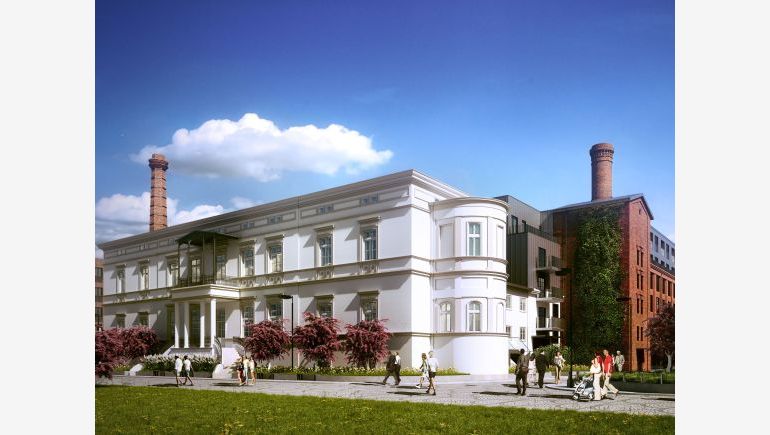Rich tradition and numerous monuments often necessitate adherence to old concept of land use planning. Particularily in the city center, the chances for creating new structures are limited and investors frequently have to undertake monument renovations. Although it seems that Balmoral Properties copartnership will be up to the task.
Historical brewery returns to its glory
Balmoral Properties, the owner of Browar Lubicz, has decided to restore the complex and give it a residential-office-services character. On the first stage of the investment, till May 2013, the market is going to be supplied with 24 5000 sq m of total area, of which the most representative part of the property – Pałac Goetzów (Goetz Palace) – is intended for offices, a reference to original, administrative function of the building. Due to restoration of the structure 2000 sq m of A-class office space is going to be created. The entire Browar Lubicz project consists of 51 000 sq m. The 200 million-worth investment's conclusion can be expected by the end of year 2014.
The architectural design, taking into account both the Municipal Plan and restorer's recommendations, have been prepared by Cracow's Pracownia MOFO Architekci studio, known for investments such as Pasaż Grunwaldzki in Wrocław or Onyx office building in Cracow. At the end of previous year the investor signed a contract with PORR Polska S.A. for general execution. Choice of contractor experienced in renovation that can boast restoring Stary Browar in Poznań or working on the grounds of Poznański's factory in Łódź ( currently Anders Hotel), leaves nothing to be desired. - Renovation of Browar Lubicz will allow to return this area to Cracow's citizens and at the same time create a modern and stylish residential-commercial complex right in the center of Cracow. The building complex at Browar Lubicz will join the urban tissue, without creating a closed enclave – everyone will be able to admire historical buildings' facades, even though the interiors of office and residential buildings won't be available for visitors – says Paweł Wassilew, Senior Sales & Marketing Manager.
History is always a great challenge for the investor. It's worth mentioning, that the first buildings making up Browar Lubicz were erected in year 1840. In 1985, Pałac Goetzów, old malt house, staircase tower with a chimney, cooling engine room, boiler room, and the chimney itself were included in the list of monuments. These buildings, maintained and renovated for nearly a hundred years, survived World War II as well, but after the war modernization and expansion of Browar Lubicz didn't resume until 1968, when Okocim moved in. Beer production in the Brewery ceased in year 2001 after acquisition of company's stocks by Carlsberg. -While planning the new structure's functions, we wanted to honour its history as well. In the open part of the complex we intend to put the few machines, which remained from the times of beer production, on display. In the old malt house on the other hand, we've provided a place for a mini-brewery, whose guests could enjoy the taste of locally produced beer in the halls of a historical brewery. Local beverages and unpasteurized beer are gaining ever greater popularity in Poland, that's why we're convinced that this concept has a chance of success – says Paweł Wassilew.
Other investment projects
City authorities can sometimes keep in check for years companies, who'd like to erect high rises in key locations. Execution of investments is made no easier by the lack of local plans plans in important parts of the city and difficulties with acquiring the so-called zoning. Its enough to mention the infamous "Szkieletor", currently a true anti-icon of Cracow or Erdal factory. In the case of the aforementioned TreiMorfa high-rise, several months ago the decision on development conditions has been retracted again. Unfortunately, DDJM office's architectural design seems to be too brave for Cracow. The current owner of Erdal factory, architect Romuald Loegler, who several years ago attempted to combine the 19th century building complex on 17 Żółkiewskiego St. with residental construction, couldn't avoid trouble as well. Existing structures have been included in the monument registry, while local residents opposed the construction of new apartment buildings. In turn, the concept of creating a Modern Art Museum there met with disapproval from the city. The deteriorating buildings house a company operating under various names in Cracow since year 1929, which produces household chemical products – and as of 1979 it houses Społdzielnia Pracy "Erdal".
Old Fabryka Miraculum didn't share the fate of the plant near Rondo Grzegórzeckie. Its grounds have quickly become Cracow's artistic enclave. For three years the postindustrial halls changed into a trendy club, while galleries, paint and sculpture workshops appeared in neighboring buildings. Currently underway in Zabłocie is the construction of Enterprise Park office complex, which is being executed by Avestus Real Estate, while the old industrial buildings have been earmarked for demolition.
Culture and entertainment comes to help, where bureaucracy stands in the way of coming to an agreement. Szkieletor could be seen from the inside under ArtBoom Festival, Fabryka Erdal shared its space for such events as Unsound Festival, while Browar Lubicz housed Photography Month – Cracow's flagship event.
